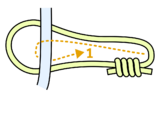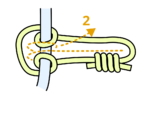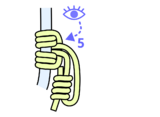Prusik knot: Difference between revisions
Appearance
mNo edit summary |
|||
| Line 14: | Line 14: | ||
== Tying == | == Tying == | ||
[[File:prusik_step1.png|160px]] | |||
[[File:prusik_step2.png|160px]] | |||
[[File:prusik_step3.png|160px]] | |||
[[File:prusik_step4.png|160px]] | |||
[[File:prusik_step5.png|160px]] | |||
'''Steps description''': | '''Steps description''': Wrap an accessory cord around a rope as illustrated (1), do it two more times (2), pull the rest of the accessory cord loop to dress the prusik (3) and try if it blocks properly (4) and visually inspect if everything looks as it should (5). | ||
== References == | == References == | ||
Revision as of 16:26, 16 August 2025
| Prusik knot | |
|---|---|
 | |
| Other names | Prusik, prusik hitch |
| Use(s) | abseiling, advanced rope techniques including (self-)rescue techniques |
| Pros | Fast, clean, just an accessory cord or a sling needed |
| Cons | Compared to traxion, tiblocs and such it is a bit tedious to get loosen in some cases and it must be moved actively |
| Category | Hitch |
| Strength | ~5-8 kN when a 5-7mm accessory cord is used[1] |
Prusik knot (technically a hitch) is a very versatile hitch used in abseiling, pulley systems, prusiking up the ropes. In some of the applications it can be replaced by tibloc and various traxions and similar devices which provides improved comfort of use by unidirectionally moving seamlessly on the rope while providing the same stopping functionality as prusik.
Tying
Steps description: Wrap an accessory cord around a rope as illustrated (1), do it two more times (2), pull the rest of the accessory cord loop to dress the prusik (3) and try if it blocks properly (4) and visually inspect if everything looks as it should (5).
References
- ↑ Jenks, Ryan (16 June 2021). Prusik, Auto Blocks, and Klemheist Break Tests. HowNOT2. Retrieved 16 August 2025.




